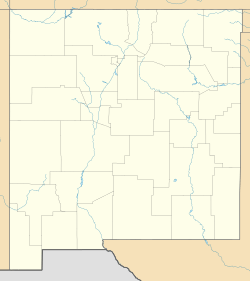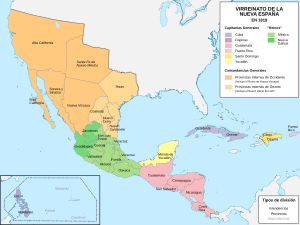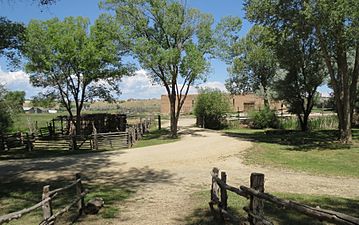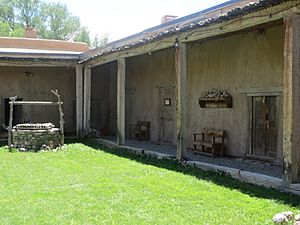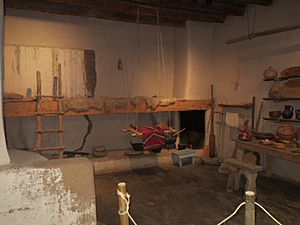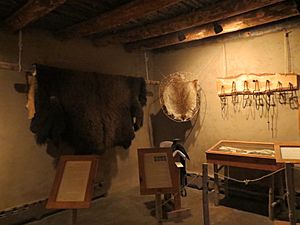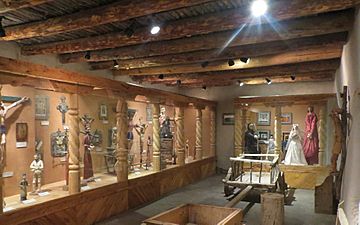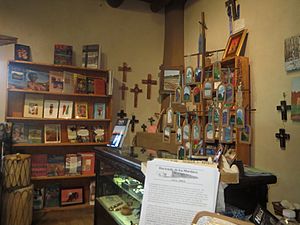Martinez Hacienda facts for kids
|
Severino Martinez House
|
|
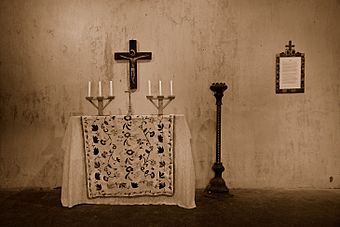
Family chapel in Martinez Hacienda
|
|
| Location | 2 mi. from Taos Plaza, on the Lower Ranchitos Rd., Taos, New Mexico |
|---|---|
| Area | less than one acre |
| Built | 1804 |
| Architectural style | Hacienda |
| NRHP reference No. | 73001153 |
Quick facts for kids Significant dates |
|
| Added to NRHP | April 23, 1973 |
The Martinez Hacienda, also called Hacienda de los Martinez, is a historic home in Taos County, New Mexico. It was built a long time ago when Spain ruled this area. Today, it is a special museum where you can see what life was like back then. This important place is listed on the National Register of Historic Places. You can find it right next to the Rio Pueblo de Taos river.
Contents
What is a Hacienda?
A Hacienda was a very large farm or estate in Spanish-speaking countries. The word comes from an old Spanish word meaning "things to be done." These large estates often had many workers. Sometimes, Native Americans worked on these haciendas.
History of the Martinez Hacienda
Building the Hacienda
Don Antonio Severino Martinez, also known as Severino Martinez, bought this land in 1804. He moved his family here from another town called Abiquiu. At first, the house had only four rooms. As Martinez became more successful, the hacienda grew much larger.
The building was made with very thick adobe walls. Adobe is a type of brick made from earth and straw. It had no windows on the outside walls. Instead, it had two inner courtyards, called placitas. A total of 21 rooms were built around these courtyards. The hacienda was built like a fortress to protect the family. It kept them safe from attacks by Plains tribes, like the Comanche and Apache. When there was danger, all the farm animals were brought inside the courtyards for safety.
The Martinez Family
Severino Martinez married Maria del Carmel Santistevan in 1787. They had six children who all lived long lives. Severino was the alcalde (which means mayor) of Taos. He was also a very successful trader and merchant.
The Martinez family owned about five square miles of land. This made their hacienda the largest in the Taos Valley. It was a busy farm and ranch. Severino raised many animals, including pigs, goats, oxen, mules, burros, horses, and sheep. They also grew crops like corn, squash, wheat, peas, and chilis. Severino had workers from the Navajo and Ute tribes to help with the farm work. Maria, his wife, managed about 30 Native American servants. These women made clothes and other items from wool and leather. The men, women, and children who worked on the farm were often acquired through trade.
Trade and Prosperity
During the time of Spanish rule, goods were either made right there or brought from Mexico City. They traveled along a famous trade route called the El Camino Real de Tierra Adentro. The Martinez Hacienda was the very last stop on this long route in the north. The museum today shows how this trade worked. After 1821, Severino also traded goods along the Santa Fe Trail.
Severino Martinez built a very successful trading business. He traded many goods, especially with places like Chihuahua, Mexico. This success allowed him to send his son, Antonio José Martínez, to study to become a priest in Durango, Mexico. Antonio José later became an important spiritual leader in Taos from 1826 to 1867.
Later Years of the Hacienda
Severino lived at the hacienda until he passed away in 1827. In his will, he left his large fortune to his six children, a nephew, and two female servants he had freed. One of these freed women was his half-sister. The Martinez family kept the property even when Mexico took control of New Mexico from Spain. They also kept it when New Mexico became a United States territory and then a state.
In 1931, the hacienda was sold outside of the family. Over the years, it started to fall apart. In 1961, Jerome Milord and his family bought it and began to fix it up. Later, in 1969 or 1972, the Kit Carson Memorial Foundation bought the property. They worked hard to restore it. By 1982, the hacienda was fully restored to look just as it did in 1820.
The Museum Today
The Martinez Hacienda is now owned by the Taos Historic Museums. It is a "living museum" that celebrates the people who first settled in the Taos Valley. It especially shows what life was like in the 1820s under Spanish rule. For example, the museum has weaving exhibits that show wool dyed with natural plant colors. The inside walls of the hacienda are painted white with tierra blanca. This is a special mix of clay and wheat paste.
This hacienda is one of the few Spanish colonial haciendas in the United States that you can visit all year round.
The museum also hosts the annual Taos Trade Fair in late September. This event recreates what Spanish colonial life was like. It celebrates the trade between mountain men, Native Americans, and Spanish settlers. You can see demonstrations by blacksmiths, wood carvers, and weavers. The museum even has a working weaving room and a blacksmith shop.
See also


